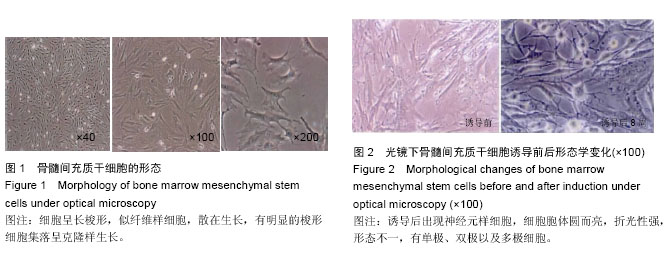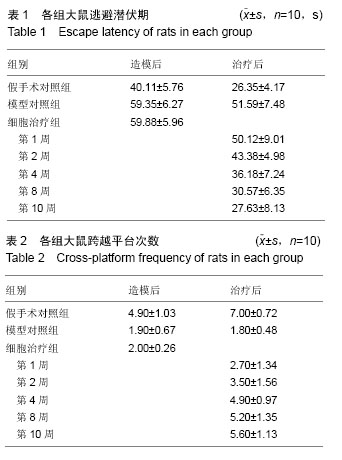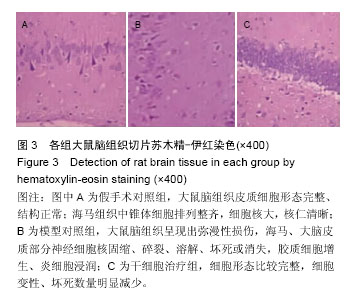| [1] Howard KL, Filley CM. Advances in genetic testing for Alzheimer's disease. Rev Neurol Dis. 2009;6(1):26-32.
[2] Park D, Yang YH, Bae DK, et al. Improvement of cognitive function and physical activity of aging mice by human neural stem cells over-expressing choline acetyltransferase. Neurobiol Aging. 2013;34(11): 2639-2646.
[3] Miller RH, Bai L, Lennon DP, et al. The potential of mesenchymal stem cells for neural repair. Discov Med. 2010;9(46):236-242.
[4] Deng YB, Ye WB, Hu ZZ, et al. Intravenously administered BMSCs reduce neuronal apoptosis and promote neuronal proliferation through the release of VEGF after stroke in rats. Neurol Res. 2010;32(2): 148-156.
[5] Andres RH, Horie N, Slikker W, et al. Human neural stem cells enhance structural plasticity and axonal transport in the ischaemic brain. Brain. 2011;134(Pt 6): 1777-1789.
[6] Delcroix GJ, Garbayo E, Sindji L, et al. The therapeutic potential of human multipotent mesenchymal stromal cells combined with pharmacologically active microcarriers transplanted in hemi-parkinsonian rats. Biomaterials. 2011;32(6):1560-1573.
[7] Si L, Xu T, Wang F, et al. X-box-binding protein 1-modified neural stem cells for treatment of Parkinson's disease. Neural Regen Res. 2012;7(10):736-740.
[8] 孙治坤,陈生弟.阿尔茨海默病的治疗[J].上海交通大学学报,2008,28(5): 596-599.
[9] Matsuoka Y, Jouroukhin Y, Gray AJ, et al. A neuronal microtubule-interacting agent, NAPVSIPQ, reduces tau pathology and enhances cognitive function in a mouse model of Alzheimer's disease. J Pharmacol Exp Ther. 2008;325(1):146-153.
[10] Srivareerat M, Tran TT, Alzoubi KH, et al. Chronic psychosocial stress exacerbates impairment of cognition and long-term potentiation in beta-amyloid rat model of Alzheimer's disease. Biol Psychiatry. 2009;65(11):918-926.
[11] Calabrese B, Shaked GM, Tabarean IV, et al. Rapid, concurrent alterations in pre- and postsynaptic structure induced by naturally-secreted amyloid-beta protein. Mol Cell Neurosci. 2007;35(2):183-193.
[12] Mahmood A, Lu D, Lu M, et al. Treatment of traumatic brain injury in adult rats with intravenous administration of human bone marrow stromal cells. Neurosurgery. 2003;53(3):697-702.
[13] 袁章,杨拯,徐艳,等.骨髓间充质干细胞向神经元样细胞分化及其在神经修复中的应用[J].中国康复医学杂志,2009, 24(8):766-769.
[14] Hwang DH, Shin HY, Kim BG.Fortuitous benefits of activity-based rehabilitation in stem cell-based therapy for spinal cord repair:enhancing graft survival. Neural Regen Res. 2015; 10 (10): 1589-1590.
[15] Yin Y, Zhou X, Guan X, et al.In vivo tracking of human adipose-derived stem cells labeled with ferumoxytol in rats with middle cerebral artery occlusion by magnetic resonance imaging. Neural Regen Res. 2015; 10(6): 909-915.
[16] Yu HB,Chen PD,Yang ZX,et al.Electro-acupuncture at Conception and Governor vessels and transplantation of umbilical cord blood-derived mesenchymal stem cells for treating cerebral ischemia/reperfusion injury. Neural Regen Res. 2014;9(1): 84-91.
[17] Cho SR, Kim YR, Kang HS, et al. Functional recovery after the transplantation of neurally differentiated mesenchymal stem cells derived from bone barrow in a rat model of spinal cord injury. Cell Transplant. 2009; 18(12):1359-1368.
[18] Dezawa M,Kanno H,Hoshino M,et al.Specific induction of neuronal cells from bone marrow stromal cells and application for autologous transplantation.J Clin Invest. 2004;113(12):1701.
[19] 乔之龙,郭蕾,李菲.补肾益智汤对老年痴呆模型大鼠中枢神经递质的影响[J].中华中医药学刊,2009,27(12):2565- 2568.
[20] 吴斌,吴永超,郑启新,等.骨髓基质干细胞在IKVAV多肽纳米纤维凝胶表面增殖、黏附及向神经细胞诱导分化的研究[J].中华创伤骨科杂志,2007,9(8):740-744.
[21] Le Blanc K, Ringdén O. Immunobiology of human mesenchymal stem cells and future use in hematopoietic stem cell transplantation. Biol Blood Marrow Transplant. 2005;11(5):321-334.
[22] Biswas SC, Shi Y, Vonsattel JP, et al. Bim is elevated in Alzheimer's disease neurons and is required for beta-amyloid-induced neuronal apoptosis. J Neurosci. 2007;27(4):893-900.
[23] Yoshimura H, Muneta T, Nimura A, et al. Comparison of rat mesenchymal stem cells derived from bone marrow, synovium, periosteum, adipose tissue, and muscle. Cell Tissue Res. 2007;327(3):449-462.
[24] Huang JI, Kazmi N, Durbhakula MM, et al. Chondrogenic potential of progenitor cells derived from human bone marrow and adipose tissue: a patient-matched comparison. J Orthop Res. 2005; 23(6):1383-1389.
[25] Corcione A, Benvenuto F, Ferretti E, et al. Human mesenchymal stem cells modulate B-cell functions. Blood. 2006;107(1):367-372.
[26] Nauta AJ, Fibbe WE. Immunomodulatory properties of mesenchymal stromal cells. Blood. 2007;110(10): 3499-3506.
[27] Krampera M, Glennie S, Dyson J, et al. Bone marrow mesenchymal stem cells inhibit the response of naive and memory antigen-specific T cells to their cognate peptide. Blood. 2003;101(9):3722-3729.
[28] Di Nicola M, Carlo-Stella C, Magni M, et al. Human bone marrow stromal cells suppress T-lymphocyte proliferation induced by cellular or nonspecific mitogenic stimuli. Blood. 2002;99(10):3838-3843.
[29] Spaggiari GM, Capobianco A, Becchetti S, et al. Mesenchymal stem cell-natural killer cell interactions: evidence that activated NK cells are capable of killing MSCs, whereas MSCs can inhibit IL-2-induced NK-cell proliferation. Blood. 2006;107(4):1484-1490.
[30] Zhang W, Ge W, Li C, et al. Effects of mesenchymal stem cells on differentiation, maturation, and function of human monocyte-derived dendritic cells. Stem Cells Dev. 2004;13(3):263-271.
[31] Beyth S, Borovsky Z, Mevorach D, et al. Human mesenchymal stem cells alter antigen-presenting cell maturation and induce T-cell unresponsiveness. Blood. 2005;105(5):2214-2219.
[32] Aggarwal S, Pittenger MF. Human mesenchymal stem cells modulate allogeneic immune cell responses. Blood. 2005;105(4):1815-1822.
[33] Suvà ML, Riggi N, Stehle JC, et al. Identification of cancer stem cells in Ewing's sarcoma. Cancer Res. 2009;69(5):1776-1781.
[34] Karnoub AE, Dash AB, Vo AP, et al. Mesenchymal stem cells within tumour stroma promote breast cancer metastasis. Nature. 2007;449(7162):557-563.
[35] Ramasamy R, Lam EW, Soeiro I, et al. Mesenchymal stem cells inhibit proliferation and apoptosis of tumor cells: impact on in vivo tumor growth. Leukemia. 2007; 21(2):304-310.
[36] Cho JS, Park HW, Park SK, et al. Transplantation of mesenchymal stem cells enhances axonal outgrowth and cell survival in an organotypic spinal cord slice culture. Neurosci Lett. 2009;454(1):43-48.
[37] 黄洁萍,翁金森,王锋,等.骨髓间充质干细胞移植对急性脊髓损伤大鼠神经功能恢复及Nogo-A 表达的影响[J].中国康复医学杂志,2009,24(7):582-586.
[38] Zheng XR, Zhang SS, Yin F, et al. Neuroprotection of VEGF-expression neural stem cells in neonatal cerebral palsy rats. Behav Brain Res. 2012;230(1): 108-115.
[39] Araki T, Kato H, Kogure K. Selective neuronal vulnerability following transient cerebral ischemia in the gerbil: distribution and time course. Acta Neurol Scand. 1989;80(6):548-553.
[40] Bartsch T, Schönfeld R, Müller FJ, et al. Focal lesions of human hippocampal CA1 neurons in transient global amnesia impair place memory. Science. 2010;328 (5984):1412-1415.
[41] 柯尊记.老年学习记忆减退的神经行为学基础[J].生理科学进展,1997,28(4): 328-330.
[42] Perez-Cruz C, Nolte MW, van Gaalen MM, et al. Reduced spine density in specific regions of CA1 pyramidal neurons in two transgenic mouse models of Alzheimer's disease. J Neurosci. 2011;31(10): 3926-3934.
[43] Li Y, Yu X, Lin S, et al. Insulin-like growth factor 1 enhances the migratory capacity of mesenchymal stem cells. Biochem Biophys Res Commun. 2007; 356(3):780-784. |
.jpg)



.jpg)